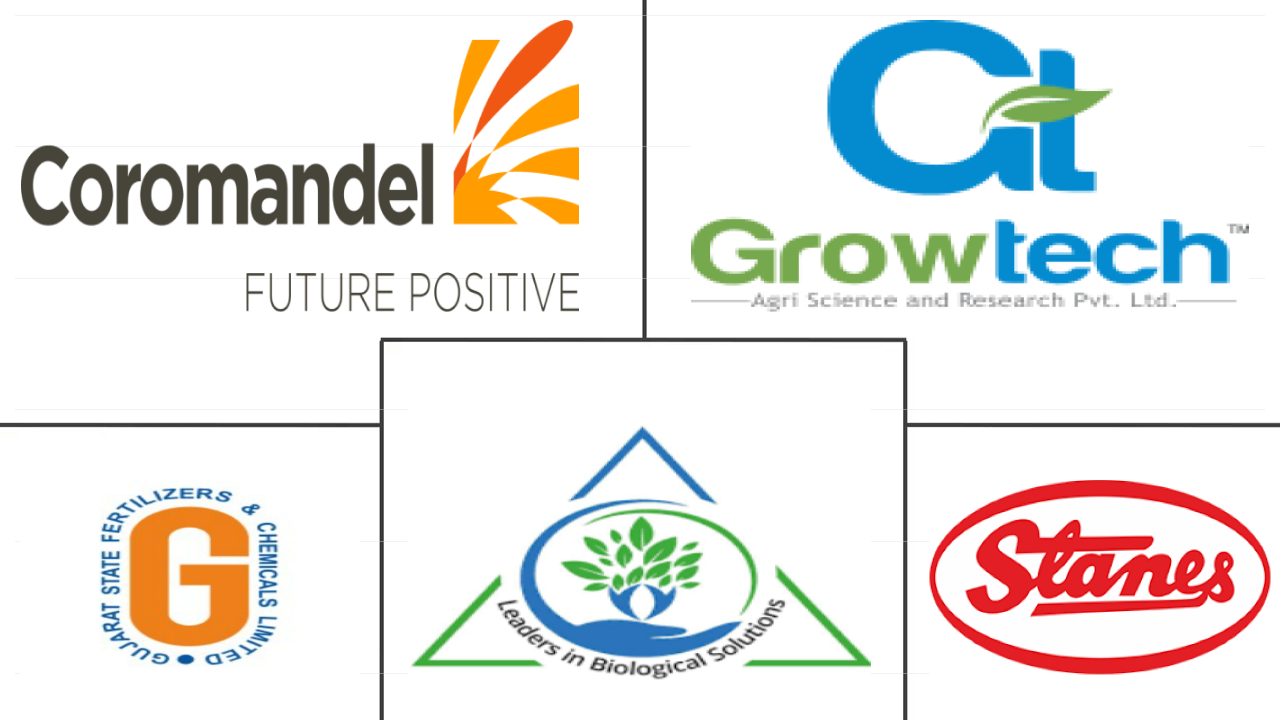Market Size of india biopesticides Industry
| Icons | Lable | Value |
|---|---|---|
|
|
Study Period | 2017 - 2029 |
|
|
Market Size (2024) | USD 217.97 Million |
|
|
Market Size (2029) | USD 347.53 Million |
|
|
Largest Share by Form | Bioherbicides |
|
|
CAGR (2024 - 2029) | 9.78 % |
|
|
Fastest Growing by Form | Bioinsecticides |
|
|
Market Concentration | Low |
Major Players |
||

|
||
|
*Disclaimer: Major Players sorted in no particular order |
India Biopesticides Market Analysis
The India Biopesticides Market size is estimated at 217.97 million USD in 2024, and is expected to reach 347.53 million USD by 2029, growing at a CAGR of 9.78% during the forecast period (2024-2029).
217.97 Million
Market Size in 2024 (USD)
347.53 Million
Market Size in 2029 (USD)
3.73 %
CAGR (2017-2023)
9.78 %
CAGR (2024-2029)
Largest by Form
30.58 %
value share, Bioherbicides, 2023
Bioherbicides consist of microorganisms such as pathogens that act as natural weedicides. Row crops dominated the bioherbicides market with a volume share of 88.5% in 2022.
Fastest by Form
10.92 %
Projected CAGR, Bioinsecticides, 2024-2029
Bacillus thuringiensis and Beauveria bassiana are most commonly used Bioinsecticides in India. Row crops dominated the bioinsecticides segment with a share of 88.4% in 2022.
Largest by Crop Type
88.53 %
value share, Row Crops, 2023
Bioinsecticides are majorly consumed in row crops in India. The dominance of row crops is due to their large organic cultivation area which is about 59.8% in the year 2022.
Fastest by Crop Type
9.81 %
Projected CAGR, Row Crops, 2024-2029
Bioinsecticides are majorly consumed in row crops in India. The dominance of row crops is due to their large organic cultivation area which is about 59.8% in the year 2022.
Leading Market Player
4.29 %
market share, Coromandel International Ltd, 2022

Coromandel International Limited offers various biopesticides derived from Azadirachtin that can control insects during all life stages such as egg, larva, pupa and adult.
- The increased public concerns about the probable adverse environmental effects associated with the use of synthetic plant protection products prompt the search for technologies and products based on biological processes to control pests.
- Out of 227 types of biopesticides, only 15 are pesticides registered in India. Neem-based pesticides, Bacillus thuringiensis, Nuclear Polyhedrosis virus, and Trichoderma are some of the major biopesticides produced and used in India.
- Biopesticides fall under the Insecticide Act (1968). Central Insecticides Board (CIB) and the Registration Committee (RC) are two “high-powered” bodies under this Act. CIB is the apex advisory. It comprises eminent scientists of all disciplines/fields concerned. The RC grants registrations to import or manufacture insecticides after scrutinizing the formulae and verifying claims of bio-efficacy and safety to human beings and animals.
- In India, several government agencies, such as the Ministry of Agriculture and Farmers Welfare, the Department of Biotechnology (DBT), and the Ministry of Science and Technology, have been promoting the research, development, and commercialization of biopesticides.
- The average consumption of pesticides in India is about 570 gm per ha. as compared to developed countries, like Japan, Thailand, and Germany, where the consumption rate is 11 kg, 17 kg, and 3 kg per ha, respectively. Though the average quantum of pesticide usage in India is low, the damage caused due to their indiscriminate usage and poor quality maintenance is alarming. In terms of value, much of the pesticide application is accounted for by a few crops. For example, cotton, paddy and vegetable crops account for 80% of the value of pesticides applied in India.
India Biopesticides Industry Segmentation
Biofungicides, Bioherbicides, Bioinsecticides are covered as segments by Form. Cash Crops, Horticultural Crops, Row Crops are covered as segments by Crop Type.
- The increased public concerns about the probable adverse environmental effects associated with the use of synthetic plant protection products prompt the search for technologies and products based on biological processes to control pests.
- Out of 227 types of biopesticides, only 15 are pesticides registered in India. Neem-based pesticides, Bacillus thuringiensis, Nuclear Polyhedrosis virus, and Trichoderma are some of the major biopesticides produced and used in India.
- Biopesticides fall under the Insecticide Act (1968). Central Insecticides Board (CIB) and the Registration Committee (RC) are two “high-powered” bodies under this Act. CIB is the apex advisory. It comprises eminent scientists of all disciplines/fields concerned. The RC grants registrations to import or manufacture insecticides after scrutinizing the formulae and verifying claims of bio-efficacy and safety to human beings and animals.
- In India, several government agencies, such as the Ministry of Agriculture and Farmers Welfare, the Department of Biotechnology (DBT), and the Ministry of Science and Technology, have been promoting the research, development, and commercialization of biopesticides.
- The average consumption of pesticides in India is about 570 gm per ha. as compared to developed countries, like Japan, Thailand, and Germany, where the consumption rate is 11 kg, 17 kg, and 3 kg per ha, respectively. Though the average quantum of pesticide usage in India is low, the damage caused due to their indiscriminate usage and poor quality maintenance is alarming. In terms of value, much of the pesticide application is accounted for by a few crops. For example, cotton, paddy and vegetable crops account for 80% of the value of pesticides applied in India.
| Form | |
| Biofungicides | |
| Bioherbicides | |
| Bioinsecticides | |
| Other Biopesticides |
| Crop Type | |
| Cash Crops | |
| Horticultural Crops | |
| Row Crops |
India Biopesticides Market Size Summary
The India Biopesticides Market is experiencing significant growth, driven by increasing public awareness of the environmental impacts of synthetic pesticides. This shift has led to a greater focus on biopesticides, which are derived from natural processes to control pests. Despite the availability of numerous biopesticide types, only a limited number are registered for use in India, with neem-based pesticides, Bacillus thuringiensis, Nuclear Polyhedrosis virus, and Trichoderma being the most prominent. The regulatory framework governing biopesticides in India is robust, with the Central Insecticides Board and the Registration Committee overseeing the registration and safety verification processes. Government initiatives from various ministries are further bolstering the research, development, and commercialization of biopesticides, aligning with the country's broader agricultural and environmental goals.
The market landscape is characterized by fragmentation, with a few key players holding a small share of the market. Companies like Coromandel International Ltd, GrowTech Agri Science Private Limited, and Gujarat State Fertilizers & Chemicals Ltd are among the leading entities. Recent mergers and acquisitions, such as those involving Coromandel International Ltd and Andermatt Biocontrol AG, are expected to enhance product offerings and streamline operations. The market's growth is also supported by the increasing demand for organic products, as consumer preferences shift towards items perceived to offer better health benefits and quality. This trend is reflected in the rising consumption of organic foods and beverages, which, despite being limited by price premiums, are gaining traction due to heightened consumer awareness and government support for organic farming initiatives.
India Biopesticides Market Size - Table of Contents
-
1. MARKET SEGMENTATION (includes market size in Value in USD and Volume, Forecasts up to 2029 and analysis of growth prospects)
-
1.1 Form
-
1.1.1 Biofungicides
-
1.1.2 Bioherbicides
-
1.1.3 Bioinsecticides
-
1.1.4 Other Biopesticides
-
-
1.2 Crop Type
-
1.2.1 Cash Crops
-
1.2.2 Horticultural Crops
-
1.2.3 Row Crops
-
-
India Biopesticides Market Size FAQs
How big is the India Biopesticides Market?
The India Biopesticides Market size is expected to reach USD 217.97 million in 2024 and grow at a CAGR of 9.78% to reach USD 347.53 million by 2029.
What is the current India Biopesticides Market size?
In 2024, the India Biopesticides Market size is expected to reach USD 217.97 million.

